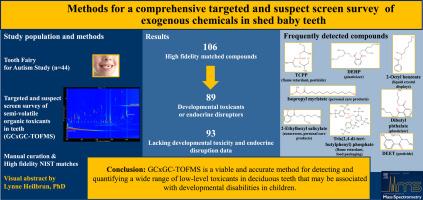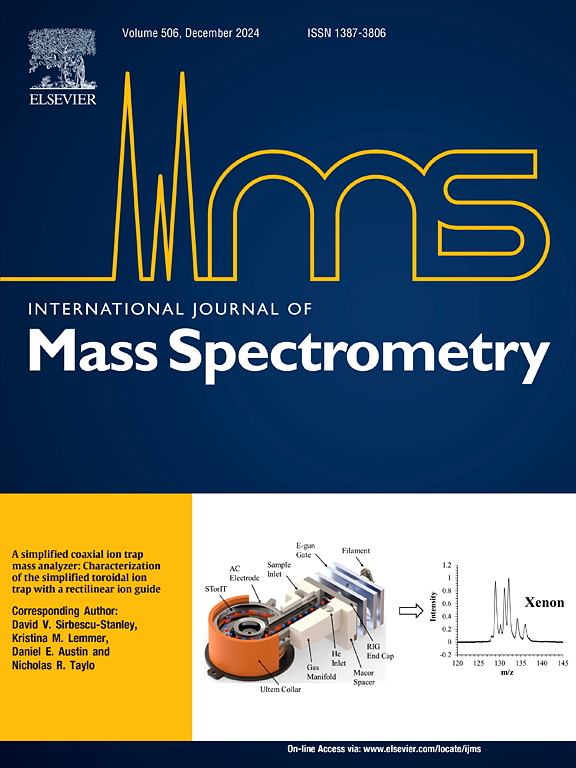Methods for a comprehensive targeted and suspect screen survey of exogenous chemicals in shed baby teeth
IF 1.7
3区 化学
Q3 PHYSICS, ATOMIC, MOLECULAR & CHEMICAL
引用次数: 0
Abstract
Background
Semi-volatile organic chemicals (SVOCs) have been studied in shed baby teeth as a potential tool to identify environmental triggers of autism. However, these targeted studies are limited by the availability of standards, leaving a vast number of chemicals unexplored for autism risk.
Objective
We explored the use of two-dimensional gas chromatography time-of-flight mass spectrometry (GCxGC-TOFMS) as a viable and accurate method for identifying and quantifying a wide range of low-level SVOCs in deciduous teeth.
Methods
Tooth samples were derived from The Autism Tooth Fairy Study. Ground tooth samples (n = 44) were analyzed using GCxGC-TOFMS. Targeted and non-targeted analyses were performed. Targeted compounds were reviewed against reference spectra for identification, and non-targets were manually curated using the National Institute of Standards and Technology Library data, as available. Kovat's retention index was used for identifications without a reference standard.
Results
From the 44 tooth samples analyzed, 11,971 total endogenous and exogenous features were cataloged, including unknowns without a suitable library match. Of the 203 compounds detected, 106 high-fidelity matched compounds were identified spanning 45 subclasses of toxicants. Eighty-nine of these compounds are known developmental toxicants or endocrine disruptors. The remaining compounds were toxicants with acute or chronic toxicity data but had no developmental or endocrine-disrupting activity data.
Conclusion
This study demonstrates the utility of GCxGC-TOFMS for detecting a wide range of SVOCs in children's teeth, identifying a substantial number of developmental toxicants and other toxic chemicals. The detection of these compounds highlights critical gaps in our understanding of children's chemical exposures.

方法:对脱落乳牙外源性化学物质进行全面、有针对性和可疑的筛查调查
半挥发性有机化学物质(SVOCs)已经在脱落的乳牙中进行了研究,作为识别自闭症环境触发因素的潜在工具。然而,这些有针对性的研究受到标准可用性的限制,导致大量的化学物质未被用于自闭症风险的研究。目的探讨二维气相色谱-飞行时间质谱法(GCxGC-TOFMS)作为鉴定和定量乳牙中多种低水平SVOCs的一种可行、准确的方法。方法牙齿样本来源于自闭症牙仙研究。采用GCxGC-TOFMS分析磨牙样品(n = 44)。进行针对性和非针对性分析。根据参考光谱对目标化合物进行鉴定,非目标化合物使用美国国家标准与技术研究所图书馆的可用数据进行手动整理。采用Kovat保留指数进行无标准品鉴别。结果从分析的44个牙齿样本中,共编目了11,971个内源性和外源性特征,包括没有合适库匹配的未知特征。在检测到的203种化合物中,鉴定出106种高保真匹配的化合物,涵盖45个毒物亚类。这些化合物中有89种是已知的发育毒物或内分泌干扰物。其余化合物是具有急性或慢性毒性数据的毒物,但没有发育或内分泌干扰活性数据。结论GCxGC-TOFMS可用于检测儿童牙齿中广泛的SVOCs,鉴定出大量发育毒性物质和其他有毒化学物质。这些化合物的检测凸显了我们对儿童接触化学物质的认识存在重大差距。
本文章由计算机程序翻译,如有差异,请以英文原文为准。
求助全文
约1分钟内获得全文
求助全文
来源期刊
CiteScore
3.60
自引率
5.60%
发文量
145
审稿时长
71 days
期刊介绍:
The journal invites papers that advance the field of mass spectrometry by exploring fundamental aspects of ion processes using both the experimental and theoretical approaches, developing new instrumentation and experimental strategies for chemical analysis using mass spectrometry, developing new computational strategies for data interpretation and integration, reporting new applications of mass spectrometry and hyphenated techniques in biology, chemistry, geology, and physics.
Papers, in which standard mass spectrometry techniques are used for analysis will not be considered.
IJMS publishes full-length articles, short communications, reviews, and feature articles including young scientist features.

 求助内容:
求助内容: 应助结果提醒方式:
应助结果提醒方式:


